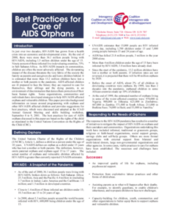In just over two decades, HIV/AIDS has grown from a health crisis into an economic and developmental crisis. By the end of 2000, there were more than 36.1 million people living with HIV/AIDS, including 1.5 million children under the age of 15. Ninety percent of those infected live in developing countries, 75% in Sub-Saharan Africa. As HIV/AIDS impacts on communities, children are often the most adversely affected. The devastating impact of the disease threatens the very fabric of the society-the family-as parents and caregivers die and leave children behind. It is estimated that more than 13.2 million children have lost a mother or both parents to the pandemic. AIDS affected children are ill prepared to face the future; they are required to care for themselves, their siblings and the dying parents, in an environment of discrimination that denies them protection of their basic human rights. Some organizations, communities and individuals have developed strategies to help HIV/AIDS affected orphans and vulnerable children. This paper provides background information on issues around programming with orphans and other HIV/AIDS affected children and provides suggestions for best practices, which were discussed and adopted at the ICAD Annual General Meeting and skills building workshop, September 8 to 9, 2001. The best practices for care of AIDS orphans discussed in this paper are based on the rights of the child as stipulated in the United Nations Convention on the Rights of the Child (CRC).
©Interagency Coalition on AIDS and Development

